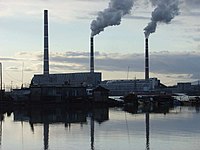
Photo from wikipedia
Abstract Developing reliable frameworks to estimate the potential of CO2 emission abatement and its associated costs merits urgent attention. This study aims to estimate the potential as well as macroeconomic… Click to show full abstract
Abstract Developing reliable frameworks to estimate the potential of CO2 emission abatement and its associated costs merits urgent attention. This study aims to estimate the potential as well as macroeconomic costs of CO2 emission abatement in Beijing. Using the industrial economy as the basis, multiobjective programming and genetic algorithm are integrated into the input–output analysis. Several important findings have been gathered in the study: (1) The abatement cost varies between $259.97 and $535.46 per ton at different rates of economic growth. (2) A reinforced emission abatement target can induce higher macroeconomic costs. (3) An inverse U-shaped relationship between CO2 reduction cost and GDP growth rate was found. When GDP growth rate is above the threshold value of 7%, marginal abatement costs decrease rapidly in parallel with GDP growth. When the GDP growth rate is below 7%, the marginal abatement cost increases significantly with economic growth. (4) Industries that have the highest and least potential of abatement have been identified. For effectively reducing CO2 emissions, Beijing needs to promote economic restructuring to maximize the potential of emission abatement and also fulfil the emission abatement target in a cost-effective way. This paper provides a quantitative approach to rationalize the policy design process of enacting emission targets and recommends cost-effective abatement strategies.
Journal Title: Journal of Cleaner Production
Year Published: 2018
Link to full text (if available)
Share on Social Media: Sign Up to like & get
recommendations!